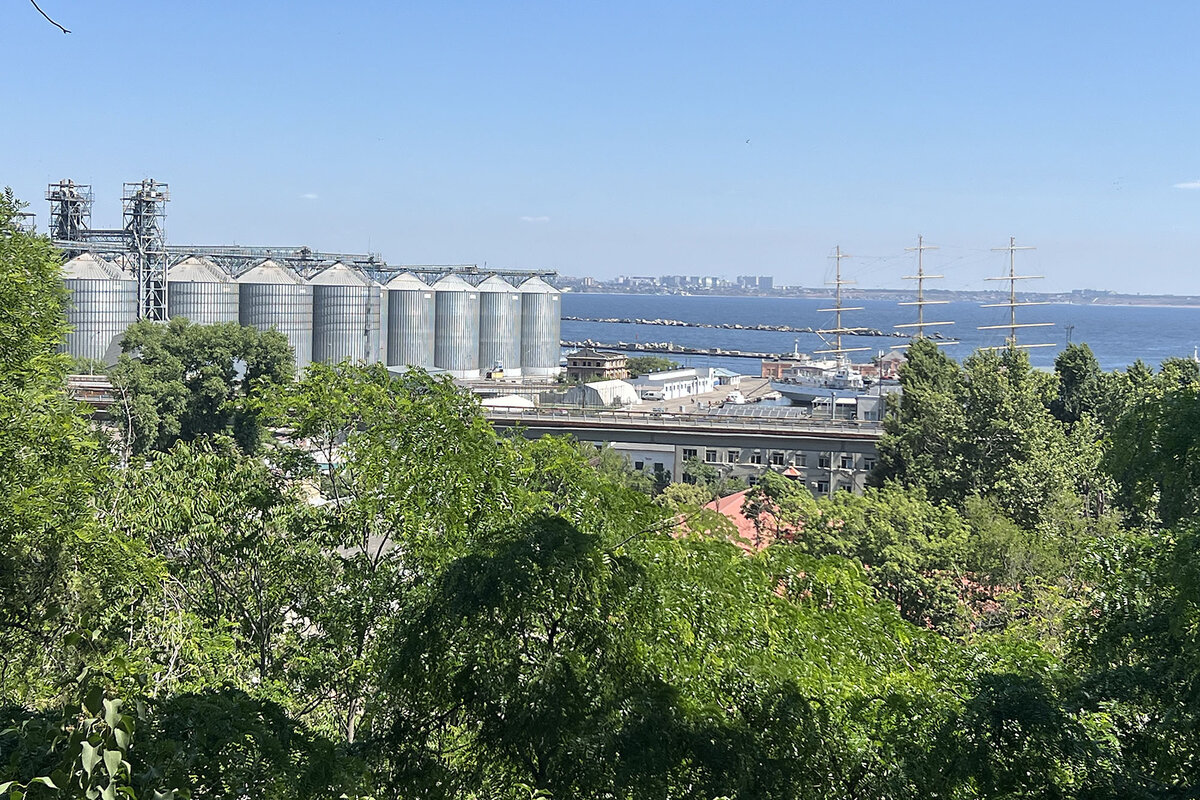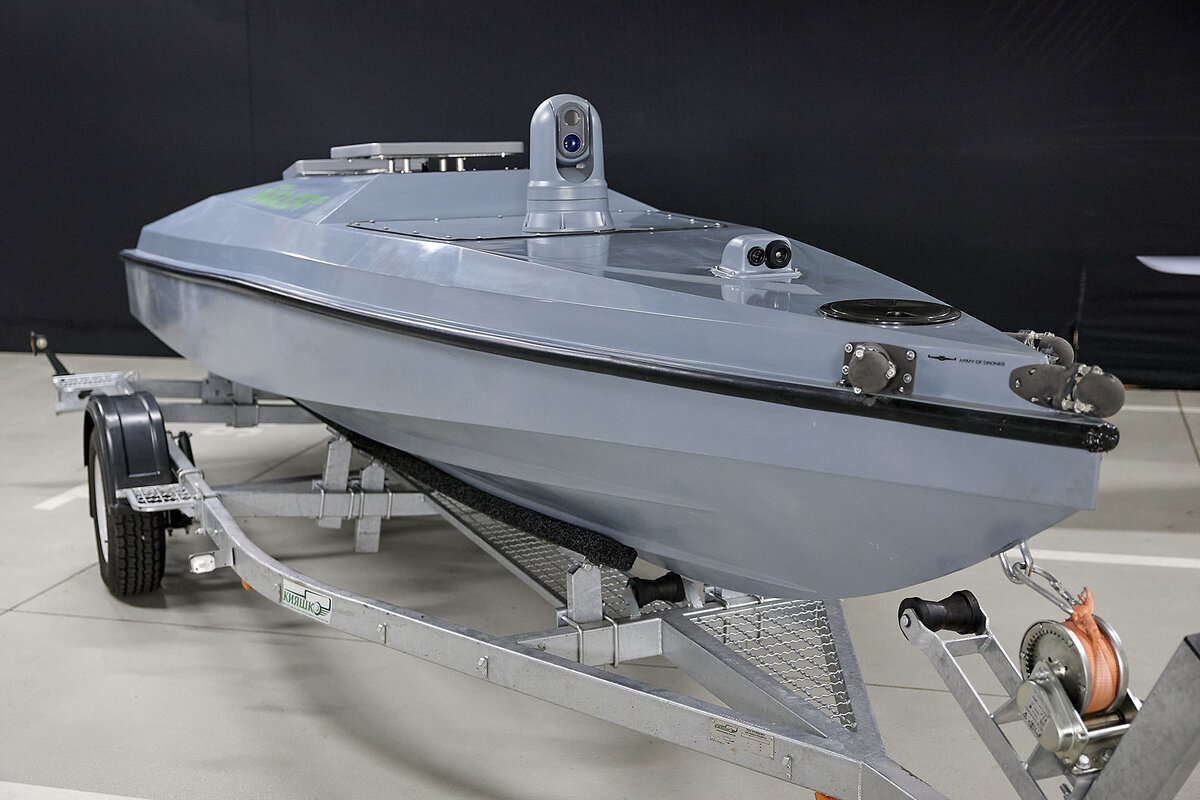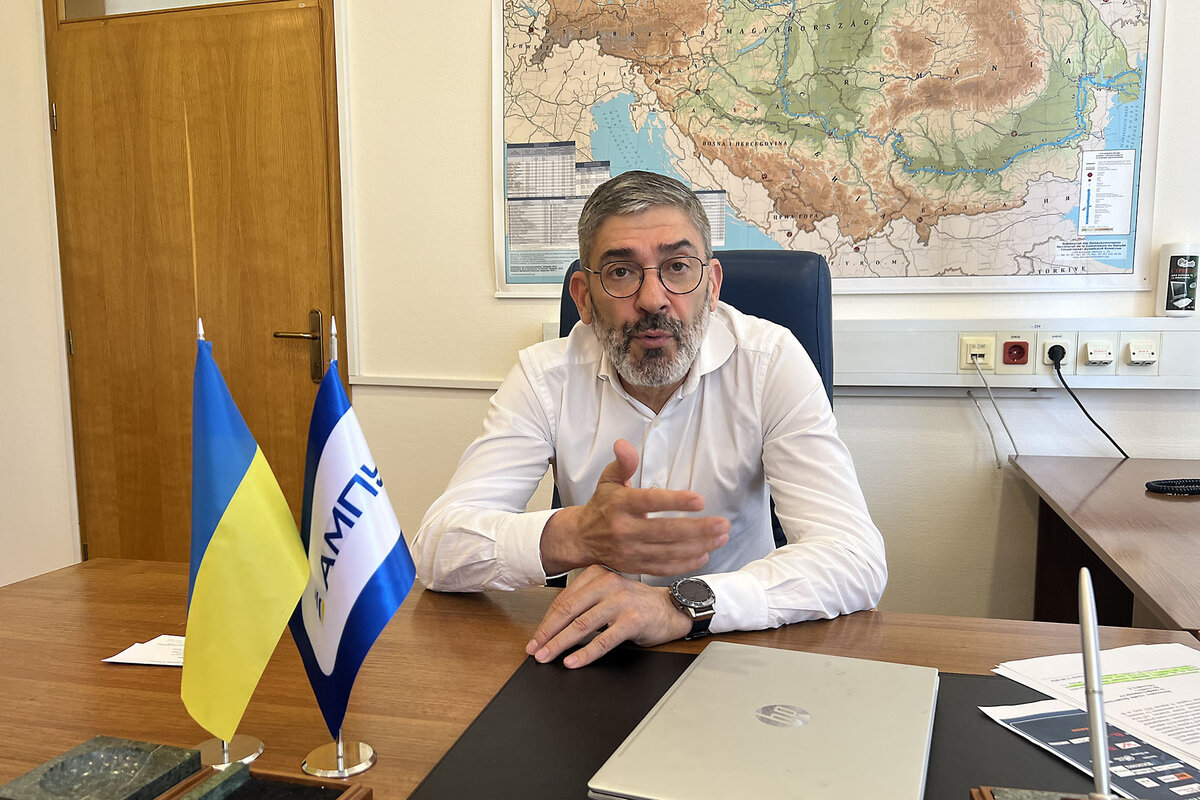How a lethal Ukrainian sea drone is protecting the global food supply
Loading...
| Odesa and Mykolaiv, Ukraine
As war closed down Black Sea shipping routes over the summer of 2022, Volodymyr Varbanets did what he says most of his fellow Odesa-region farmers did with their harvests.
“It was hard and expensive to export with the sea routes shut down, so we kept our harvests in the silos,” says the owner of a 540-acre farm where he grows wheat, barley, sunflower, and other crops in the rolling hills outside the port city of Odesa.
But this year, Mr. Varbanets expects to get back to exporting about 70% of his crops to overseas markets – thanks, he says, to the Ukrainian military’s ability to reopen a maritime trade corridor along the country’s Black Sea coastline.
Why We Wrote This
A story focused onOne lesson of the Russia-Ukraine war is that Ukrainian farmers’ prosperity and the world’s food security are very much linked. Now, in David-and-Goliath fashion, a Ukrainian sea drone has been deployed in the Black Sea to help keep the grain flowing.
“I don’t know exactly what countries receive my wheat and other crops,” says the director of the 4,200-member Odesa Region Farmers Association. “What I do know,” he adds, standing in a field of thigh-high, undulating wheat, “is that Ukrainian grains are needed to feed the world – just as we have to sell those grains to keep farming.”
Indeed, the return of Ukrainian grains to the global food market is good news not just for the country’s farmers, but also for the many developing countries of the Middle East, Africa, and Southeast Asia that depended on one of the world’s premier breadbaskets for steady food supplies before Russia’s full-scale invasion in February 2022.
As war disrupted the trade routes that transported much of Ukraine’s grain and other food exports, food prices skyrocketed and global food insecurity spread. A multinational grain trade deal eased the food crunch somewhat – until Russia pulled out of the deal in July 2023.
But over the past year, Ukraine’s stunning and largely unheralded success in opening up a secure and dependable Black Sea shipping corridor has put the country on track to return its grain exports to nearly prewar levels.
Even though Odesa is vulnerable to the occasional long-range Russian missile attack, Ukraine grain exports in April reached 6.3 million tons, the most for one month since before the war.
Effective use of sea drone
There are a number of explanations for this success, but perhaps chief among them is Ukraine’s development of a plucky but deadly little uncrewed boat, or sea drone, that over recent months has pushed Russia’s formidable navy far from Ukraine’s southern coast – and from key seaports like Odesa.
The sea drones, which look something like small speedboats – and can carry up to 1,000 pounds of explosives – have sunk so many enemy naval vessels that Russia has been forced to withdraw its sea operations to safer waters.
Of the 80 warships Russia assigned to the Black Sea before the invasion, at least a third have been either destroyed or disabled, Ukraine’s military says. Much of that damage has been inflicted by sea drones.
“These drones are like a slingshot in the hands of the Ukrainians as they go up against the Russian Goliath,” says Daniel Fiott, head of the Defence and Statecraft Programme at the Brussels School of Governance. “They can operate day and night and strike their lethal blows with surprise,” he adds, “and we can see the evidence that they are having significant impact on Russian morale.”
Russian President Vladimir Putin’s repeated sacking and reshuffling of naval chiefs is glaring proof of his frustration over Russia’s loss of Black Sea dominance, Dr. Fiott says. The sting is no doubt sharper, he adds, as it comes at the hands of a country with no navy to speak of.
The homegrown sea drones are not enough to determine the course of the war, which remains primarily a land-based slog along Ukraine’s eastern and northern borders with Russia. But the vessels are playing a critical role in foiling Mr. Putin’s goal of bringing Ukraine’s economy to its knees, many experts and officials say.
“For the Russians, this war is clearly economic. It’s all about destroying Ukraine’s industrial and economic strengths,” says Artem Vashchilenko, coordinator of a business community plan to build a new, diversified economy in Mykolaiv, a former Soviet shipbuilding capital.
“When the war started, Russia’s big naval vessels were an important element in this economic war – they controlled the sea and struck fear in us, and that strangled our economy,” he says. “But these small drones have changed the paradigm of the sea wars,” he adds. “Their message is, ‘Don’t be afraid of the Russians; now it’s their turn to fear us!’”
Ukraine trade corridor
Still, the sea drones are no panacea for Ukraine’s southern coastline. As effective as they may be, they are of no help to Mykolaiv, which sits on an estuary upstream from the Black Sea – and just opposite a spit of land occupied by Russia.
Where the sea drones have proved to be game changers is 80 miles west at the ports in and near Odesa.
“We now have 100 cargo ships a day that want to come and load up with Ukrainian grains and iron ore, a significant increase from just a few months ago,” says Dmytro Barinov, deputy CEO of the Ukrainian Sea Ports Authority in Odesa. “We owe much of that success to the sea drones and some missile strikes that have destroyed so many of the Russian ships that threatened our ports and shipping lanes.”
Displaying a map depicting the steady retreat of Russian war vessels away from Ukraine to safer Black Sea waters south and east, Mr. Barinov smiles. “They’ve even removed their vessels from Crimea,” the Ukrainian peninsula that Russia has occupied since 2014.
The newly dubbed Ukraine trade corridor – which hugs the country’s Black Sea coastline until it reaches the secure waters of adjacent NATO countries – has been a boon to Ukraine’s war-dampened economy, Mr. Barinov says. But he adds that it also provides relief for the world’s hungry people.
“When you remember that half of the World Food Program’s food supplies come from Ukrainian grains, you understand the importance of this trade corridor to people in many parts of the world,” he says.
Looking forward, Mr. Barinov says the continued security of the trade corridor will be critical to realizing the next goal for Ukraine’s ports, which is to expand exports beyond the traditional grains and iron ore to other goods including fertilizers, construction materials, and steel products.
“The sea ports are critical to rebuilding Ukraine’s economy,” he says, “and the trade corridor is what will allow the ports to fulfill that purpose.”
Ukraine’s defense industry
Others say the story of the homegrown sea drones has the potential to change the way the world thinks about Ukraine – and to put the country back on the map of the world’s premier defense industries.
During the Soviet era, Ukraine was responsible for about 20% of the USSR’s defense production capability.
“The made-in-Ukraine sea drones are chipping away at the superior depth the Russians thought they had in the Black Sea,” says Dr. Fiott. “That is telling the world that Ukraine has the know-how and the defense industrial base that are capable of doing this,” he adds. “But it is also telling us something about how Ukraine is trying to position itself in the postwar world.”
Analysts say Ukraine’s success likely will be noticed in regions with similar geopolitical tensions.
“We can say that Ukraine is the first country in the world with experience in both developing and deploying this type of drone in real combat circumstances,” says Oleksandr Kovalenko, military and political director for the Informational Resistance Group, a defense think tank based in Kyiv.
“We might find the U.S. buying sea drones from us one day, why not?” he chuckles. “But I think it will be more for U.S. partners like Taiwan, for example, that this technology will be very relevant.”
Dr. Fiott says he imagines Ukraine is thinking big as it contemplates how to capitalize on its successful use of industrial power and knowledge to “punch through the asymmetry” it faced on the Black Sea.
“They are clearly seeing the part this innovative defense industrial base can play as they look toward future NATO and [European Union] accession,” he says. “It positions them as applicants with something very attractive to bring to the table.”
Oleksandr Naselenko and Volodymyr Pecherskyi assisted in reporting this story.










